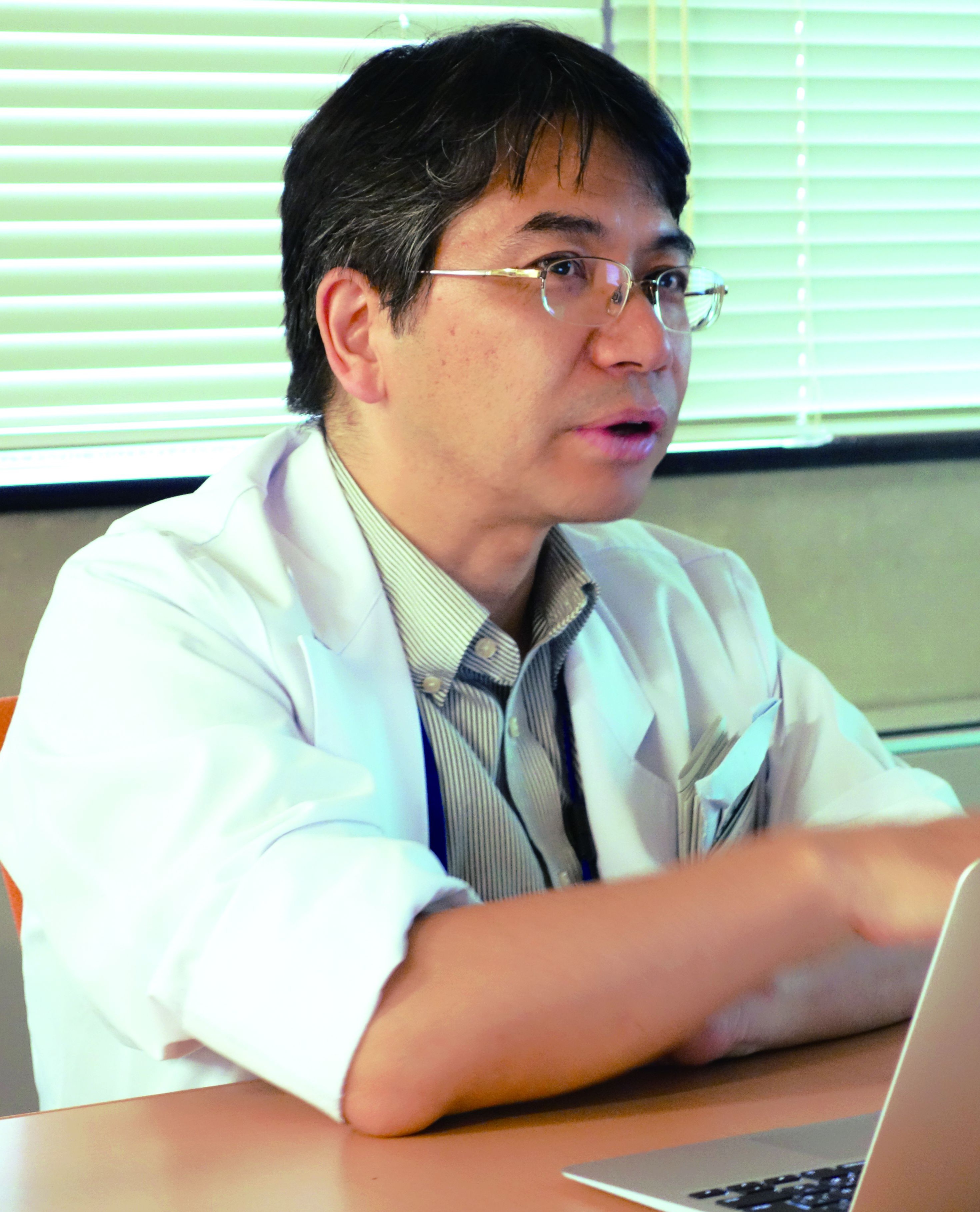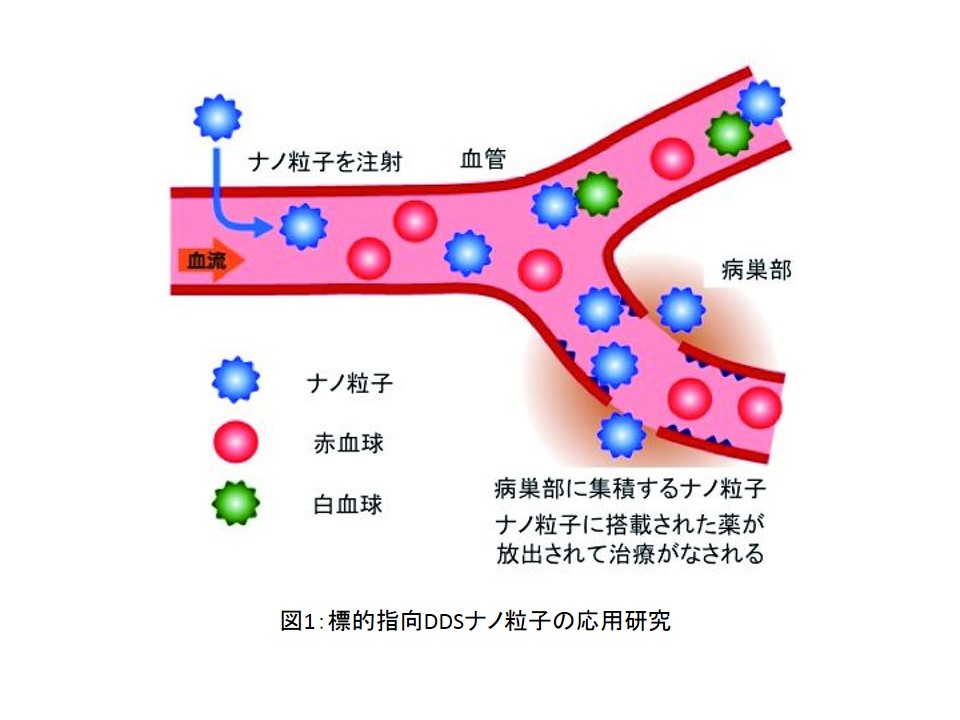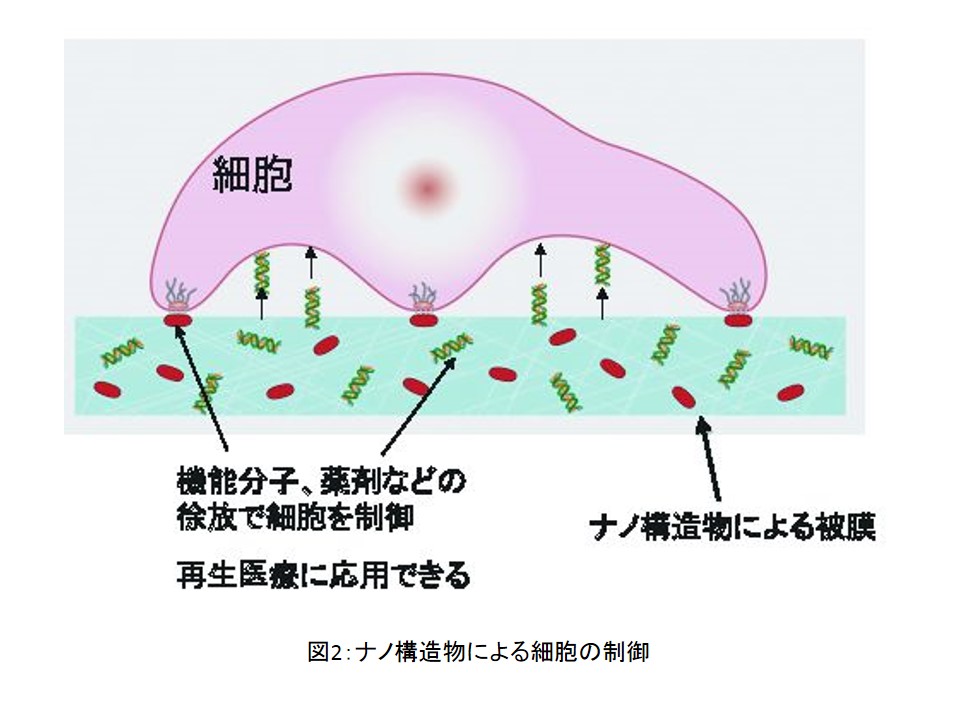キーワード:ナノ粒子、DDS、Nanomedicine、臨床応用
 薬には、主作用と副作用があります。なぜ、薬には副作用がつきものなのでしょうか。それは、薬が患部だけでなく、患部以外の場所にも拡散して運ばれているからです。副作用を少なくするためには、薬を患部へ集中的に運ぶ必要があります。このシステムは、ドラッグデリバリーシステム(DDS: Drug Delivery System)と呼ばれています。本リサーチユニットでは、DDSとしてナノ粒子やナノ構造物を用いて、様々な疾患に対する新しい治療法の開発を行っています。
薬には、主作用と副作用があります。なぜ、薬には副作用がつきものなのでしょうか。それは、薬が患部だけでなく、患部以外の場所にも拡散して運ばれているからです。副作用を少なくするためには、薬を患部へ集中的に運ぶ必要があります。このシステムは、ドラッグデリバリーシステム(DDS: Drug Delivery System)と呼ばれています。本リサーチユニットでは、DDSとしてナノ粒子やナノ構造物を用いて、様々な疾患に対する新しい治療法の開発を行っています。
患部だけに薬を届けるナノ粒子
ナノ粒子・ナノ構造物は、目的に応じて使い分けており、たとえば、血液中に投与して患部だけに届けたいならナノ粒子を使います。私たちは、「病巣部は、他の組織に比べてpHが低い」という性質を利用して、低いpHでのみ分解して活性酸素を除去する機能を持った、非常に小さい粒子(ナノ粒子)を作製しました。これを体内に投与すると、病巣部でのみ効果を発揮し、他の組織への影響が最小限に抑えられると考えられます(図1)。実際に、このナノ粒子を実験動物に投与したところ、脳梗塞に対して、著しい病状改善が見られました。

患部だけに薬を届け、さらに濃度を一定に保つナノ構造物
また、患部で薬の濃度を長時間一定に保つことも重要なので、たとえば手術の場所だけに薬を届け、薬の濃度を一定に保ちたい場合は、生体材料にナノ構造物を組み込んで使います。私たちは、体内に埋め込む生体材料(例:人工骨など)の表面に被膜(ナノ構造物)を構築し、この中に薬を入れる技術を開発しました。これにより、薬を少しずつ放出すること(徐放)が可能になり、患部でのみ薬効を発揮します(図2)。この技術を用いた生体材料は、動物実験で有効性を示し、今年度中にもヒトの治療に応用される予定です。
筑波研究学園都市には、多くの研究機関が集結しています。この強みをいかして、今後、筑波研究学園都市内で連携して様々なナノ粒子やナノ構造物の開発をすすめ、本学医学部でナノ構造物DDSを臨床応用し、筑波発の薬 (nanomedicine)を世に出していければ、と考えています。

社会への貢献・実績
● pH反応性ナノミセルの実用化
● 潰瘍性大腸炎の新規薬剤の開発
● 脳梗塞の新規薬剤の開発
● 動脈硬化症の新規治療法の研究
● 劇的に改善された新規癌温熱療法
(取材:平成25年7月24日)
Create “Ideal Drugs” without Adverse Effects Using Nanoparticles and Nanostructures
Unit members : Matsui, Hirofumi Matsuzaka, Takashi
Key words: nanoparticles, DDS, nanomedicine, clinical application
Drugs have main and adverse effects. Drugs have adverse effects because they spread to unaffected areas. To reduce such adverse effects, drugs should be concentrated in affected areas. This involves the use of a drug delivery system (DDS). Our research unit is developing new treatments for various diseases using nanoparticles and nanostructures as DDSs.
use of a drug delivery system (DDS). Our research unit is developing new treatments for various diseases using nanoparticles and nanostructures as DDSs.
Nanoparticles to deliver drugs only to affected areas
Nanoparticles and nanostructures are used for different purposes. For example, nanoparticles are used to deliver drugs only to affected areas by injection into the blood. In general, the pH is lower in affected than in unaffected areas. Using this property, we prepared very small particles (nanoparticles) that only degrade at a low pH to eliminate active oxygen. The nanoparticles are administered into the body to exert effects only in affected areas, minimizing their effects in unaffected areas (Figure 1). In fact, nanoparticles have been administered to experimental animals with cerebral infarction, markedly improving the symptoms.

Figure 1 : Applied research on targeted DDS nanoparticles
Nanostructures that deliver drugs only to affected areas and maintain constant drug concentrations
Constant drug concentrations should be maintained for a long time in affected areas. Thus, for example, nanostructures are incorporated into biological materials to deliver drugs only to surgical sites and maintain constant drug concentrations. We developed a technique to coat (nanostructure) the surface of a biological material (e.g., artificial bone) to be implanted, in which a drug has been incorporated. This facilitates sustained drug release, exerting effects only in the affected area (Figure 2). Biological materials prepared using this technique have been effective in animal experiments, and should be applied to human treatments within this fiscal year.
Many research institutions have gathered in The Tsukuba Science City. Taking advantage of this, the Faculty of Medicine, University of Tsukuba will collaborate with them to develop various nanoparticles and nanostructures and apply nanostructure DDSs to medical practice in order to develop new Tsukuba drugs (nanomedicines).

Figure 2 : Cell control using nanostructures
Social contributions and achievements
● Practical application of pH-reactive nanomicelles.
● Development of new drugs for ulcerative colitis.
● Development of new drugs for cerebral infarction.
● Research on new treatments for arteriosclerosis.
● Improved hyperthermia treatments for cancer.
